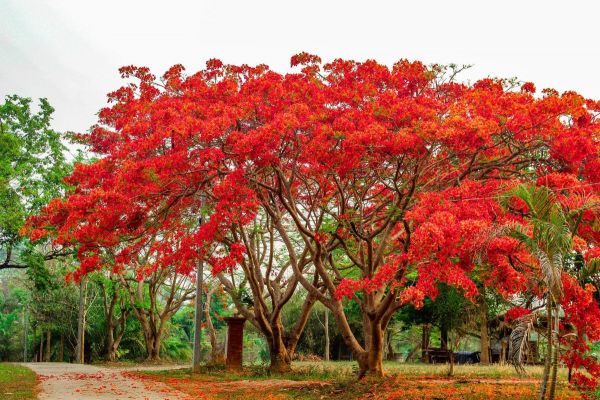Orange Flowering trees immediately catch your eyes. They may not be as popular as annual plants but with proper placement, they can elevate your garden appearance. These trees are mostly short in nature comparatively.
Orange is a color that immediately catches the eyes with its bright burst of color. There are several kinds of trees that bloom orange flowers and are must-adds in your garden or yard.
Here are 10 varieties of trees that bloom gorgeous orange flowers that you can add to your yard:
1. Jamaican Rain Trees
The Jamaican Rain tree (Brya ebenus) is a popular and common tree in the United States even though it is actually from the West Indies. The colorful orange flowers and the long, oval leaves make it easier to identify this tree. However, orange is not the only color this tree’s flowers bloom in, some other colors you can find include white and yellow.
Quick Facts:
- Size: Up to 30 feet tall
- Bloom Season: Summer
- Growing Conditions: Full sun
- USDA Growing Zone: 10
- Soil Type: Neutral to slightly acidic
2. Geiger tree
The Geiger tree is an evergreen tree that blooms beautiful orange flowers. This tree loves tropical zones but does not favor cold environments. Their growth rate is slow but in their native environment, they can get quite big. The tree flowers almost year-round but thrive in warm summer time.
Quick Facts:
- Size: Up to 25 feet tall
- Scientific Name: Cordia sebestena
- Bloom Season: All year round, but predominant during summer
- USDA Growing Zone: 10b to 11
- Growing Conditions: Full sun
- Soil Type: Neutral, well-drained
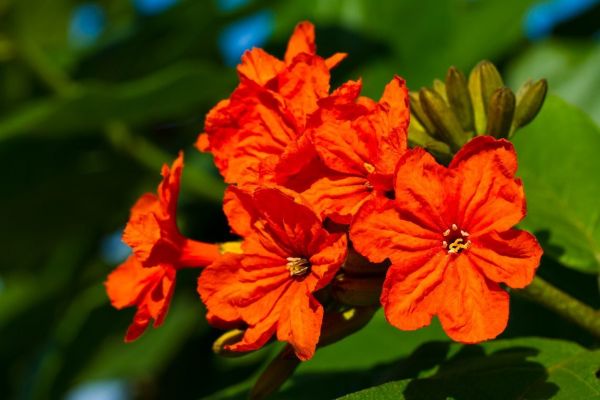
You may also be interested in: 12 Small Evergreen Shrubs for Enhancing Your Landscape
3. Royal Poinciana
Royal poinciana is a huge evergreen tree mostly known for its orange flowers during summer. It consists of a broad crown when mature. Since it has a wide canopy, the best idea would be to plant the royal poinciana where there is abundant space.
Quick Facts:
- Size: 30 to 40 feet tall
- Scientific Name: Delonix regia
- Bloom Season: Summer
- USDA Growing Zone: 9 to 11
- Growing Conditions: Full sun exposure
- Soil Type: Not picky on the type of soil
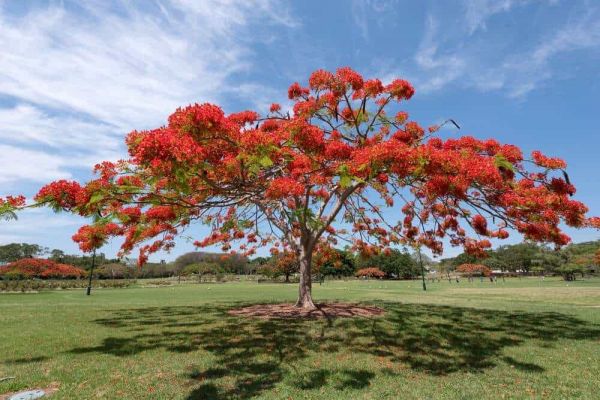
4. African tulip tree
The African tulip is a large tree with a massive crown. It is popular for its orange bloom but is actually considered an invasive plant in tropical climates. The tree has a cluster of orange flowers within the deep green foliage. Since it is a large tree, it is not the best for smaller yards or gardens and you need a big space in case you’re thinking about growing it.
Quick Facts
- Size: Up to 60 feet tall
- Scientific Name: Spathodea campanulata
- Bloom Season: Winter to late spring
- USDA Growing Zone: 11 to 12
- Growing Conditions: Full sunlight
- Soil Type: Rich, well-drained
5. Red silk cotton tree
The Red Silk Cotton tree is common in the United States for its orange bloom even though it is native to Australia. It is a fast-growing tree and gets as tall as it is wide. During the flowering season in spring, it sheds all its leaves before flowering.
Quick Facts:
- Scientific Name: (Bombax ceiba)
- Size: 70 feet tall
- Bloom Season: Spring
- USDA Growing Zone: 10 to 12
- Growing Conditions: Full sunlight
- Soil Type: Neutral, well-drained
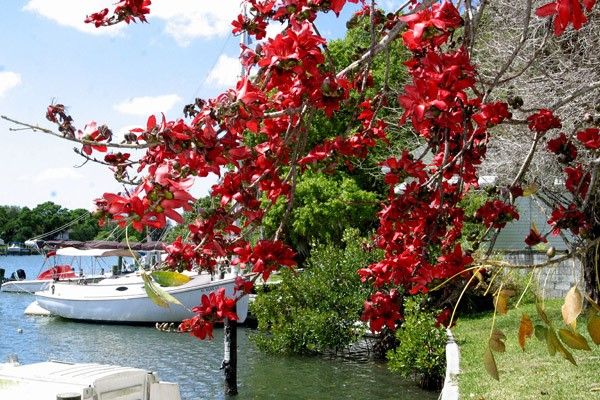
You may also like to read: 20 Plants That Thrive in Dry Conditions for Sandy Soil
6. Vera Wood
The vera wood is a large tree with a huge impressive crown. It is a slow growing tree that can be used for its yellow-orange blooms. These amazing trees feature compound leaves with as many as 24 leaflets. Other than the orange bloom, this tree is also tolerant to dry weather and not picky when it comes to soil type.
Quick Facts
- Size: 20 to 30 feet tall
- Scientific Name: Bulnesia arborea
- Bloom Season: Summer
- USDA Growing Zone: 9 to 12
- Growing Conditions: Full sun
- Soil Type: Grows in most soils
7. Pomegranate
The pomegranate is obviously a popular tree for its highly nutritious and tasty fruit. However, the orange bloom is quite underrated. Not only do these trees attract birds, the beautiful flowers also are amazing to see for the naked eye.
It also has some varieties of shorter options which are a good fit for small yards and also larger varieties that grow tall making it ideal for larger gardens. In addition to this, they are also easy to care for and are perfect for beginners.
Quick Facts
- Scientific Name: Punica granatum
- Size: 3 feet to 30 feet tall
- Bloom Season: April to June
- USDA Growing Zone: 7 to 10
- Growing Conditions: Full sun
- Soil Type: Not picky with soil type
8. Fragrant orange tea olive
The fragrant orange tea olive is popular for its eye-catching orange flowers and its pleasant smell. This evergreen tree has dense foliage with leathery leaves that has its color and texture throughout the year. The dense foliage makes it perfect for hedges around the garden.
Quick Facts:
- Scientific name: (Osmanthus fragrans f. aurantiacus)
- Size: 10 to 15 feet tall
- Bloom Season: April
- USDA Growing Zone: 8 to 11
- Growing Conditions: Full sun to partial shade
- Soil Type: Acidic, well-drained
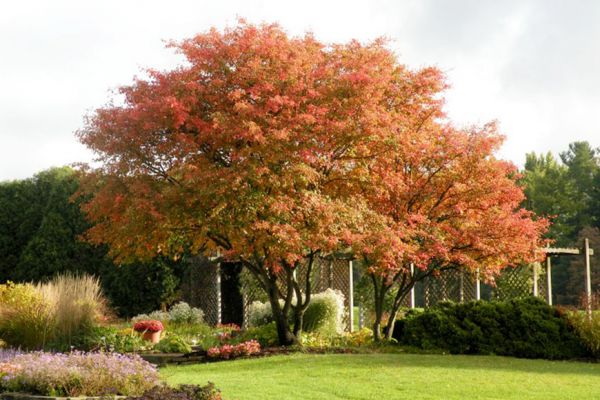
9. Flame of the Forest
Flame of the Forest isn’t called that just because it sounds cool. It does actually resemble a flame. It is a mid-sized tree having the feature of twisting trunks with maturity. After the bloom, the pods with a single seed replace the flowers. It doesn’t bloom if the cold is too much as it prefers summer climate.
Quick Facts:
- Scientific Name: Butea frondosa
- Size: 30 to 40 feet tall
- Bloom Season: Summer
- USDA Growing Zone: 10 to 12
- Growing Conditions: Full sun to partial shade
- Soil Type: Organically rich, well-drained soil
10. Orange champaca tree
The orange champaca tree is known for its unique flower colors. It has cream, orange-colored flowers coupled with the evergreen foliage. You can also trim the large crown into a round shape if you like it that way. Furthermore, it gives off a wonderful smell that will make your entire garden smell amazing.
Quick Facts
- Scientific Name: Michelia champaca
- Size: 30feet tall
- Bloom Season: Winter through spring
- USDA Growing Zone: 10 to 12
- Growing Conditions: Full sun
- Soil Type: Thrives in any soil
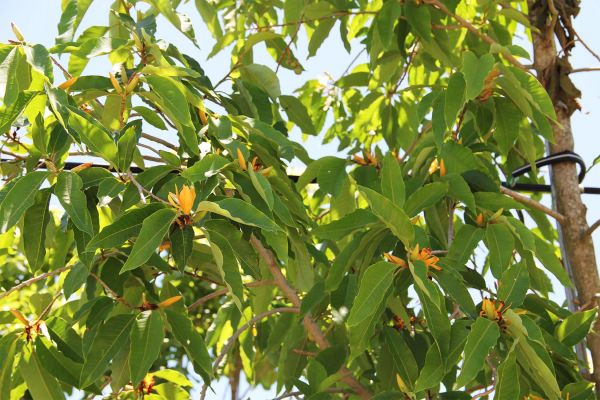
FAQs:
1. Are orange blooming trees beautiful?
Yes, orange blooming trees are beautiful and can elevate the beauty of your garden or yard by making it look brighter.
2. Which orange blooming trees should i plant?
There are a varieties of orange blooming trees you can plant such as the orange champaca, pomegranate, fragrant orange tea olive, etc.
3. Is the African tulip tree invasive?
Yes, it is popular for its orange bloom but is actually considered an invasive plant in tropical climates.
